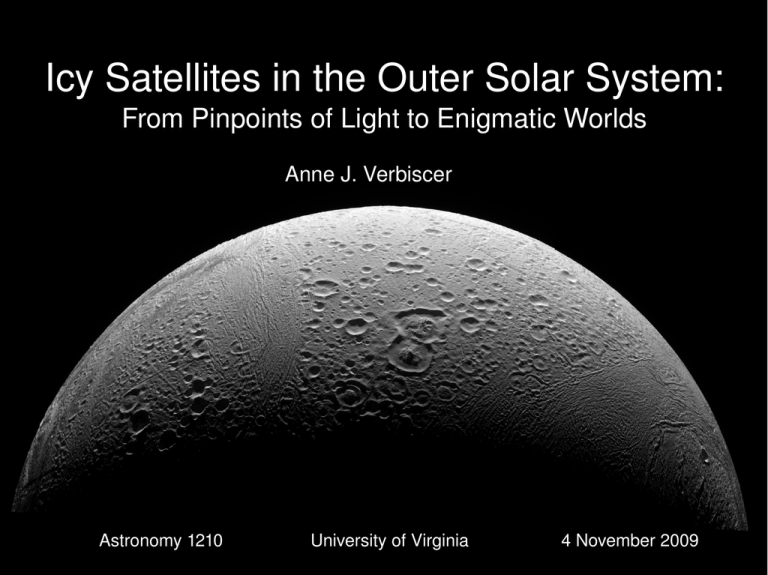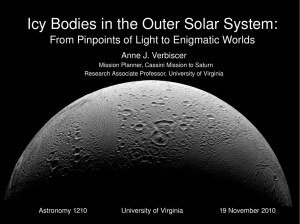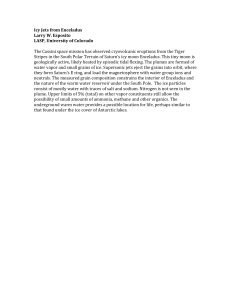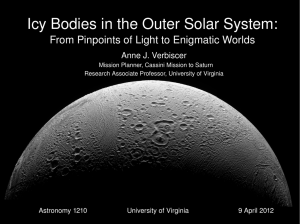Icy Satellites in the Outer Solar System: From Pinpoints of Light to Enigmatic Worlds Anne J. Verbiscer Astronomy 1210 University of Virginia 4 November 2009
advertisement

Icy Satellites in the Outer Solar System: From Pinpoints of Light to Enigmatic Worlds Anne J. Verbiscer Astronomy 1210 University of Virginia 4 November 2009 Our view of icy satellites has dramatically changed... To this! From this... SATURN View of Saturn (bright center) and several satellites from the 60­inch telescope on Mt. Palomar Enceladus False color mosaic of images taken by the Cassini­Huygens spacecraft in 2005. Prior to the 1970s, all we knew about outer planet moons (satellites) came from studying timy pinpoints of light seen through ground­based telescopes: Callisto Europa Io JUPITER Ganymede We thought that these moons might resemble our own..... with surfaces dominated by impact craters: As an example, observe how our view of Jupiter's moon Europa improves in images acquired by the spacecraft Pioneer 10, Voyager, and Galileo: Pioneer 10 December 1973 Voyager 1979 Galileo 1995­1998 And at even higher resolution....... Very few impact craters! 30 km Europa as seen by the Galileo Spacecraft in the 1990s Ice Cliffs on Europa! 1.7 km Landslides Clearly, this does not look like our Moon... Aerial view of Providence, RI at the same scale (900 m/pixel) There are >160 natural satellites (moons) in the outer solar system! All Major satellites: size: > 300 km, generally spherical orbit: make one rotation with each revolution around their planet (synchronous rotation; tidally locked) composition: densities nearly match that of water ice, 1 g/cm3 In outer solar system, ice geology reigns: Ice is a Rock! Temperature determines type of surface geology: Morphology of impact craters Volcanic features (flows, calderas) Ice tectonics (folds, grooves, ridges, fractures) Active 5152 km 504 km Active Active Pluto Charon Active Weywot Jupiter's Galilean Satellites and our own Moon to scale Density (g/cm3) 3.5 3642 3.0 3038 3.3 3474 Diameter (km) 1.9 5268 1.8 4820 Jupiter's Io ­ the most geologically active satellite Volcanic plume Volcanoes powered by tidal heating Density 3.5 g/cm­3 Infrared view shows hot plumes on nightside of Io EUROPA Europa has a subsurface ocean. Europa's surface is mostly (white.blue) water ice, with darker, redder linea (lines) composed of hydrated salts and carbonates, possibly extruded onto the surface through these fractures from the salty ocean below. Ice 'rafts' on Europa's surface broke free when layer beneath them melted.... then it all refroze GANYMEDE is the largest moon in the Solar System (larger than Mercury) Has its own magnetic field! (Iron core) Surface features on Ganymede illustrate extensional tectonics.... Ganymede has expanded since its formation, and the grooves seen in detail below are evidence of this expansion Grooved, bright terrain (fewer craters, younger) Dark terrain (more craters, older) Most of the surface is heavily cratered as seen here: CALLISTO Outermost Galilean moon May have subsurface ocean Knobby Terrain TITAN Second largest moon in Solar System (larger than Mercury) Only one with thick, nitrogen atmosphere Density 1.9 g/cm3 Diameter 5152 km Surface of Titan from the Huygens lander 14 January 2005 Rocks are ~20 cm across A cryovolcano? Near­infrared image from Cassini Changes in appearance of surface features indicate current geologic activity Cassin RADAR imagery Lakes of liquid hydrocarbons (methane and ethane) near north pole Ontario Lacus lake near south pole Dunes sweep across equatorial region (no lakes) Two Saturnian Ice Balls: Impact Craters Central peaks Large Basins Conentric rings MMAS aka 'Death Star' Density 1.15 g/cm3 TETHYS Density 0.97 g/cm3 Tethys would float! Two more Saturnian Icy Moons DIONE Density 1.5 g/cm3 RHEA Density 1.2 g/cm3 'Wispy' Terrain = fractures Only on trailing hemispheres (remember these are tidally locked and always keep the same face toward Saturn) Some of Saturn's Smaller Satellites Why do their surfaces look so different? Location, location, location Sharply defined craters, pits Crater rims are softened and muted HYPERION = 0.6 g/cm3 360 x 280 x 225 km Craters have been filled in by dust and ejecta TELESTO <<1 ? 29 x 22 x 20 km JANUS = 0.6 g/cm3 193 x 173 x 137 km Some of Saturn's Smaller Satellites Why do their surfaces look so different? Location, location, location Sharply defined craters, pits Crater rims are softened and muted HYPERION = 0.6 g/cm3 360 x 280 x 225 km Craters have been filled in by dust and ejecta TELESTO <<1 ? 29 x 22 x 20 km JANUS = 0.6 g/cm3 193 x 173 x 137 km JANUS and TELESTO orbit within Saturnian rings, subjecting their surfaces to repeated impacts, blasts HYPERION is further from Saturn, outside such a productive impact zone Equatorial Ridge Voyager Mountains IAPETUS Density 1.1 g/cm3 Two of Uranus' icy satellites which show evidence of geologic activity: Cryovolcanic flows MIRANDA = 1.2 g/cm3 472 km ARIEL = 1.7 g/cm3 1158 km NEPTUNE'S TRITON Geysers driven by sublimation Lava lakes Has a thin, nitrogen atmosphere Density 2.1 g/cm3 2706 km 1981 Voyager 2 ENCELADUS Geologically young terrain, But just how young? Density ~1 ? 504 km Enceladus within Saturn's E ring Before 2005, the relationship between Enceladus and the E ring was only a theory. Enceladus (tiny black dot) In 2005, the Cassini Spacecraft observes active eruptions from the south pole of Enceladus, which feed the E ring 2005 Cassini view of ENCELADUS Revised Density = 1.6 ! More rock in core? Does this mean more heating from radioactive decay of that rock? ENCELADUS is a (relatively) tiny ACTIVE moon with plumes of water ice and vapor erupting from four fractures near its south pole Temperatures (Kelvins) Heat Source? Tides? Radioactivity? Ammonia may provide a clue.... The Cassini spacecraft sees water plumes erupting from these four warm fractures Heat emanating from these four fractures is Localized – as high as ~ 200 K ! (White = hot; Grey = cool) ENCELADUS' 'TIGER' STRIPES Damascus Baghdad South Pole Cairo Alexandria Plume eruption sites are found along or near these four prominent fractures Damascus Sulcus 10 km Eruption site Eruption site Raw, unprocessed image of ENCELADUS acquired on 2 November 2009 shows transition region near south pole from 'ropy' terrain to cratered terrain Cratered terrain (older) Ropy terrain (younger) To south pole (jet source region) View from Cassini's cameras on Nov. 2, 2009, looking nearly directly back at the Sun. Why are there bright and dark features? ENCELADUS Main rings (dark) jets F ring Pandora (small, irregularly­shaped moon, orbits just outside F ring) Saturn's F ring and Enceladus' jets are bright because they scatter light efficiently in the 'forward' direction, just like dust on a car windshield. Enceladus itself is dark because it is behind Saturn, so there is no Saturn­shine or Sun­shine on its surface. Stay tuned for much more close­up imaging! ENCELADUS flyby 21 November 2009 http://saturn.jpl.nasa.gov/photos/raw/ How will our views of these pinpoints of light be transformed in 2015 when the New Horizons spacecraft flies by Pluto?






